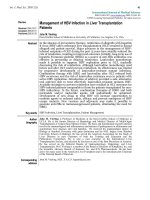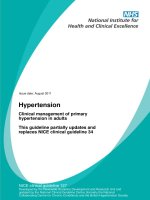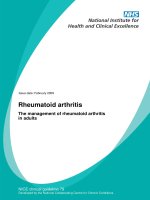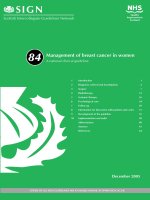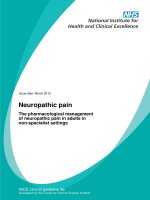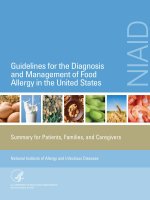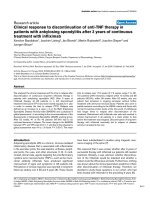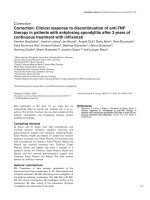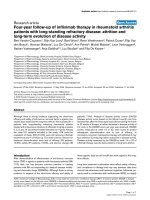Management of antithrombotic therapy in patients undergoing invasive procedures
Bạn đang xem bản rút gọn của tài liệu. Xem và tải ngay bản đầy đủ của tài liệu tại đây (489.73 KB, 12 trang )
The
n e w e ng l a n d j o u r na l
of
m e dic i n e
review article
Current Concepts
Management of Antithrombotic Therapy
in Patients Undergoing Invasive Procedures
Todd H. Baron, M.D., Patrick S. Kamath, M.D., and Robert D. McBane, M.D.
M
ore than 6 million patients in the United States receive
long-term anticoagulation therapy for the prevention of thromboembolism due to atrial fibrillation, placement of a mechanical heart-valve prosthesis, or venous thromboembolism.1 In addition, dual antiplatelet therapy (combination treatment with aspirin and a thienopyridine) after the placement of a
coronary-artery stent has dramatically increased. Annually, 10% of patients taking
antithrombotic agents undergo surgical or other invasive procedures that require
temporary discontinuation of therapy.2 Although the goal is to minimize thromboembolic events and major hemorrhage in the periprocedural period, data from
randomized, controlled trials in this area are limited, and many recommendations
are derived from single-center cohorts, particularly with regard to bridging anticoagulation therapy. In addition, there are minimal data on procedure-specific bleeding rates in this patient population.
Guidelines from scientific societies with graded levels of evidence, as well as
prior review articles, provide direction for periprocedural management of antithrombotic agents.2-12 This review provides approaches and recommendations that
are based on recent changes in national guidelines2,13 for patients undergoing invasive procedures while receiving antithrombotic therapy, including newer antithrombotic agents.14,15
From the Divisions of Gastroenterology
and Hepatology (T.H.B., P.S.K.), Cardiovascular Diseases (R.D.M.), and Hematology (R.D.M.), Mayo Clinic, Rochester, MN.
Address reprint requests to Dr. Baron at the
Division of Gastroenterology and Hepatology, Mayo Clinic, 200 First St. SW, Rochester,
MN 55905, or at
N Engl J Med 2013;368:2113-24.
DOI: 10.1056/NEJMra1206531
Copyright © 2013 Massachusetts Medical Society.
GENER A L C ONCEP T S
The question of whether antithrombotic therapy should be suspended in a patient who
will be undergoing an invasive procedure involves balancing the risk of postprocedural bleeding with continued treatment against the thrombotic risk with suspension
of treatment and use of bridging anticoagulation therapy. In general, a patient undergoing a procedure that is associated with a low risk of bleeding (low-risk procedure)
can safely continue antithrombotic therapy and should do so, particularly if the patient is at high risk for a thromboembolic event (high-risk patient). Conversely, a patient undergoing a high-risk procedure can temporarily discontinue antithrombotic
agents safely if the patient is at low risk for a thromboembolic event (low-risk patient).
The decision-making process is challenging when patients at moderate-to-high
risk for thromboembolic events undergo high-risk procedures. Management also
differs between elective and emergency procedures. A discussion among a clinician
specializing in periprocedural management of antithrombotic agents and coagulation disorders, the primary provider prescribing these agents, and the proceduralist is essential. Ideally, this communication should occur well in advance of the
procedure to maximize patient safety and facilitate patient education.2 Appropriate
decision making requires knowledge of thrombotic risk, procedure-related bleeding
n engl j med 368;22 nejm.org may 30, 2013
2113
The New England Journal of Medicine
Downloaded from nejm.org at UNIV OF MEDICINE AND DENTISTRY OF NJ on June 17, 2013. For personal use only. No other uses without permission.
Copyright © 2013 Massachusetts Medical Society. All rights reserved.
The
n e w e ng l a n d j o u r na l
risk, concepts of bridging anticoagulation therapy, and timing of cessation and reinitiation of
antithrombotic therapy. The first step in antithrombotic management is to assess the risk of
thromboembolic events during the period when
antithrombotic agents are to be discontinued.
A SSE SSMEN T OF THROMBO T IC R ISK
ATRIAL FIBRILLATION
Periprocedural risks of discontinuing antithrombotic therapy are extrapolated from risks outside
the periprocedural period. For patients with nonvalvular atrial fibrillation, important determinants of the risk of stroke include the CHADS2
score16 (Table 1) and, more recently, the
CHA2DS2-VASc score, which includes cardiovascular atherosclerotic disease and female sex as
additional risk factors.17 Scores on the CHADS2
range from 0 to 6, with higher scores indicating
a greater risk of stroke; congestive heart failure,
hypertension, diabetes, and an age of 75 years or
older are each assigned 1 point, and prior stroke
or transient ischemic attack is assigned 2 points.
Scores on the CHA2DS2-VASc range from 0 to 9,
with higher scores indicating greater risk. For
the CHA2DS2-VASc score, an age of 65 to 74 years
is assigned 1 point and an age of 75 years or
older is assigned 2 points. Valvular atrial fibrillation implies the coexistence of severe valvular
heart disease (mechanical valvular prosthesis or
mitral-valve repair), and affected patients are at
high risk for thromboembolism.
MECHANICAL HEART VALVES AND VENOUS
THROMBOEMBOLISM
of
m e dic i n e
and venous thromboembolism are outlined in
Table 2. The risk is influenced by the type, number, and location of valvular prostheses, as well
as by the presence or absence of associated heart
failure, atrial fibrillation, history of thromboembolism, and intracardiac thrombi.19,20
In patients with venous thromboembolism,
the risks of recurrent thrombosis, thrombus
propagation, and embolization are elevated for
3 months after the diagnosis and initiation of
anticoagulation therapy.21 The risk of recurrence differs depending on whether the venous
thromboembolism was provoked (in which case
the risk decreases with resolution of the underlying risk factor) or unprovoked (i.e., idiopathic)
(Table 2).22
CANCER
Patients with cancer have an increased risk of
periprocedural thrombosis owing to cancer-specific prothrombotic activity, hormonal therapy,
angiogenesis inhibitors, radiotherapy, and the
presence of indwelling central venous catheters.23
Concurrently, there is an increased risk of bleeding24 because of the administration of prophylactic agents for the prevention of venous thromboembolism, chemotherapy-related hepatic and renal
dysfunction and thrombocytopenia, and tumor
friability. An increasing number of outpatients
with cancer-related thrombosis and a history of
recurrent thrombosis before the cancer diagnosis are receiving long-term parenteral anticoagulation therapy.25
CORONARY STENTS
Some patients with coronary stents may require
Risk factors for thromboembolic events in pa- dual antiplatelet therapy indefinitely. Premature
tients with one or more mechanical heart valves discontinuation of antiplatelet therapy in anticiTable 1. CHADS2 Scoring System for Assessing the Risk of Stroke among Patients with Atrial Fibrillation.*
CHADS2 Score or Assessment
Risk of Stroke
Stroke Rate per 100 Patient-Yr
range (95% CI)
Score of 0, 1, or 2
Low
Score of 3 or 4
Moderate†
Score of 5 or 6, stroke or TIA within previous
3 mo, or severe valvular heart disease
High
1.9–4.0 (1.2–5.1)
5.9–8.5 (4.6–11.1)
12.5–18.2 (8.2–27.4)
*Scores on the CHADS2 range from 0 to 6, with higher scores indicating a greater risk of stroke; the categories of congestive heart failure, hypertension, diabetes, and an age of 75 years or older are each assigned 1 point, and the category
of prior stroke or transient ischemic attack (TIA) is assigned 2 points. CI denotes confidence interval.
†If the risk of stroke is moderate, assessment of the patient’s individual risk–benefit tradeoff for the discontinuation of
antithrombotic agents is particularly important.
2114
n engl j med 368;22 nejm.org may 30, 2013
The New England Journal of Medicine
Downloaded from nejm.org at UNIV OF MEDICINE AND DENTISTRY OF NJ on June 17, 2013. For personal use only. No other uses without permission.
Copyright © 2013 Massachusetts Medical Society. All rights reserved.
Current Concepts
Table 2. Risk Factors for Thromboembolic Events in Patients with a Mechanical Heart Valve or History of Venous Thromboembolism.
Patient History
Risk Factors for Thromboembolism*
Low Annual Risk
Moderate Annual Risk
High Annual Risk
Mechanical heart valve
Bileaflet aortic-valve prosthesis
without atrial fibrillation,
prior stroke or thrombo
embolic event, or known
intracardiac thrombus
Bileaflet aortic-valve prosthesis
and atrial fibrillation
Any mitral-valve prosthesis,
any caged-ball or tilting-disk
aortic-valve prosthesis, multiple mechanical heart valves,
or stroke, TIA, or cardio
embolic event
Venous thromboembolism
Venous thromboembolism
>12 mo previously and
no other risk factor (e.g.,
provoked and transient)
Venous thromboembolism within
previous 3–12 mo, nonsevere
thrombophilia†, or recurrent
venous thromboembolism
Venous thromboembolism within
previous 3 mo, severe thrombophilia,‡ unprovoked venous
thromboembolism, or active
cancer (cancer diagnosed
≤6 mo or patient undergoing
cancer therapy)
* Annual-risk categories for thromboembolism are defined as follows: low, an annual rate of less than 5%; moderate, an annual rate of 5 to
10%; and high, an annual rate of more than 10%. The assessment of a patient’s individual risk–benefit tradeoff for discontinuation of antithrombotic agents is particularly important in patients at moderate risk.
† Nonsevere thrombophilia is diagnosed if the patient is heterozygous for factor V Leiden or heterozygous for a mutation in the prothrombin
gene G20210A.18
‡Severe thrombophilia is diagnosed if the patient has a protein C, protein S, or antithrombin deficiency; has the antiphospholipid syndrome
(presence of antiphospholipid antibodies or lupus anticoagulant); is homozygous for factor V Leiden; is homozygous for a mutation in the
prothrombin gene G20210A; or has compound heterozygous mutations of these two genes.18
pation of a surgical or other invasive procedure
may lead to stent thrombosis26,27 and precipitation of myocardial infarction, with a mortality
rate of 50% or higher.2
The risk of stent thrombosis differs between
bare-metal stents and drug-eluting stents. The
risk of thrombosis is highest within 6 weeks
after the placement of a bare-metal stent and
within 3 to 6 months after the placement of a
drug-eluting stent28; antiplatelet therapy is required for at least 1 month after placement of a
bare-metal stent and for 1 year after placement
of a drug-eluting stent.29 After acute coronary
syndromes, continuation of dual antiplatelet
therapy is recommended for up to 12 months in
patients with bare-metal stents and for at least
12 months in patients with drug-eluting stents,
unless the risk of bleeding is excessive.30 The
optimal duration of dual antiplatelet therapy for
patients with coronary stents remains unknown.
However, recent studies suggest that 6 to 12
months may be appropriate, with little to gain
from a longer duration.31,32
risk factors include residual effects of antithrombotic agents, active cancer and chemotherapy,
history of bleeding, and reinitiation of antithrombotic therapy within 24 hours after the
procedure.33 Table S1 in the Supplementary Appendix, available with the full text of this article
at NEJM.org, shows commonly performed procedures and associated bleeding risks; classification into high-risk and low-risk categories is
based on guidelines and reviews coupled with
expert opinion within our institution.
Grades of bleeding severity are not standardized across specialties.34 The American Society
for Gastrointestinal Endoscopy designates lowrisk procedures as those with clinical rates of
bleeding of 1.5% or less.35 In the absence of
specific risk stratification, we propose that highrisk procedures are those with a rate of bleeding
of more than 1.5% among patients not receiving
antithrombotic agents. In addition, procedures
that can result in intracranial, intraspinal, intraocular, retroperitoneal, intrathoracic, or pericardial bleeding are high-risk, with bleeding in
these locations classified as major.34 Neuraxial
anesthesia is a high-risk procedure.36,37
A SSE SSMEN T OF PER IPRO CEDUR A L
For other procedures, we determine the severBL EEDING R ISK S
ity of bleeding using criteria similar to those
The risk of major periprocedural bleeding de- used for gastrointestinal endoscopic procedures
pends on the type of procedure, and additional (Table S2 in the Supplementary Appendix).38
n engl j med 368;22 nejm.org may 30, 2013
2115
The New England Journal of Medicine
Downloaded from nejm.org at UNIV OF MEDICINE AND DENTISTRY OF NJ on June 17, 2013. For personal use only. No other uses without permission.
Copyright © 2013 Massachusetts Medical Society. All rights reserved.
The
n e w e ng l a n d j o u r na l
BR ID GING A N T IC OAGUL AT ION
THER A PY
Bridging anticoagulation therapy is designed to
minimize the risk of thromboembolism in highrisk patients when anticoagulation therapy is
suspended (Tables 1 and 2) and to minimize the
risk of bleeding after high-risk procedures (Table
S2 in the Supplementary Appendix). The need for
bridging depends on the duration of action of the
anticoagulant agent and the potential for reversing
anticoagulation. In most cases, bridging anti
coagulation therapy is used in patients receiving
warfarin. Once warfarin has been discontinued
and the international normalized ratio (INR) falls
below the therapeutic range, intravenous unfractionated heparin or subcutaneous low-molecularweight heparin is administered for 3 to 5 days.
The heparin agent is withdrawn before the procedure, with the timing based on whether unfractionated heparin or low-molecular-weight heparin is used, and is usually readministered 48 hours
after the procedure, if hemostasis is secured.
Although the use of bridging anticoagulation
therapy in high-risk patients is considered the
standard of care, it has been evaluated in only
two randomized, controlled trials39,40 and remains
controversial.41,42 The results of an ongoing trial
of the use of bridging therapy in high-risk patients are awaited.43 The available data are difficult to interpret because high-risk and low-risk
patients and high-risk and low-risk procedures
have been pooled. Older studies used nonperioperative data to estimate perioperative risks of
stroke and thromboembolism during a period of
of
m e dic i n e
8 to 10 days of warfarin interruption. Rates of
thrombosis were estimated to be quite low (0.1
to 0.4% among patients with a mechanical heart
valve and <0.1 to 0.2% among those with atrial
fibrillation39). However, actual overall rates
(with and without bridging) are higher: 1.2%
among patients with a mechanical heart valve,
0.9% among those with atrial fibrillation, and
1.8% among those with venous thromboembolism.44 Corresponding rates of major bleeding
(with and without bridging) are 2.7%, 2.0%, and
1.9%, respectively.44
A recent meta-analysis showed that periprocedural bridging therapy with heparin increased
the overall risk of major bleeding without a significant decrease in the risk of thromboembolic
events.42 This conclusion has been affirmed in the
study by Birnie et al. in this issue of the Journal.40
This single-blind, randomized study involved
patients at moderate-to-high risk for thromboembolic events who were undergoing pacemaker
or defibrillator surgery. A clinically significant
device-pocket hematoma was more common in
the heparin-bridging group (16.0%) than in the
continued-warfarin group (3.5%). Major surgical
and thromboembolic complications were rare in
both treatment groups.
When bridging therapy is required for highrisk patients with an estimated creatinine clearance of less than 30 ml per minute, the use of
unfractionated heparin is preferred. High-dose
unfractionated heparin (therapeutic anticoagulation)2 is commonly used, with monitoring of the
activated partial-thromboplastin time. For low-risk
patients, such as those with an episode of venous
Table 3. Approach to Bridging Therapy.
Condition
Mechanical heart valve
Bridging Therapy Required
No Bridging Therapy
Comments
Mitral-valve replacement, two or
Aortic-valve replacement, bileaflet
more mechanical valves, non
prosthesis, and no additional
bileaflet aortic-valve replacement,
risk factors
or aortic-valve replacement with
other risk factors
Other risk factors include prior
stroke, TIA, intracardiac
thrombus, or cardioembolic
event
Nonvalvular atrial fibrillation Prior stroke or embolic event, cardiac No prior stroke or embolic event,
absence of cardiac thrombus,
thrombus, or CHADS2 score of ≥4
or CHADS2 score of <4
Prior stroke, TIA, intracardiac
thrombus, or cardioembolic
event increases risk
Venous thromboembolism
2116
Venous thromboembolism within
Venous thromboembolism >3 mo Consider inferior vena cava filter if
previous 3 mo or severe thrombopreviously or no additional risk
venous thromboembolism ocphilia
factors (e.g., active cancer and
curred <1 mo previously, if urnonsevere thrombophilia)
gent or emergency surgery is
required, or if there is a contraindication to anticoagulation
therapy
n engl j med 368;22 nejm.org may 30, 2013
The New England Journal of Medicine
Downloaded from nejm.org at UNIV OF MEDICINE AND DENTISTRY OF NJ on June 17, 2013. For personal use only. No other uses without permission.
Copyright © 2013 Massachusetts Medical Society. All rights reserved.
Current Concepts
thromboembolism more than 3 months before the
planned procedure, prophylactic low-dose heparin
can be used for bridging.2 In moderate-risk patients, the decision to use bridging therapy and
the degree of intensity of bridging therapy
should be individualized and the patient’s wishes
considered.2
Our approach to bridging therapy, shown in
Table 3, is consistent with published guidelines.2
The protocol is as follows. Stop warfarin 5 days
before a high-risk procedure, and when the INR
falls below the therapeutic range, begin lowmolecular-weight heparin at a therapeutic dose.
For patients with a mechanical heart valve or
atrial fibrillation, use enoxaparin at a dose of
1 mg per kilogram of body weight, administered
every 12 hours, or dalteparin at a dose of 100 IU
per kilogram, administered every 12 hours. For
patients with venous thromboembolism, use
enoxaparin at a dose of 1.5 mg per kilogram or
dalteparin at a dose of 200 IU per kilogram once
daily. The final dose (either enoxaparin at a dose
of 1 mg per kilogram or dalteparin at a dose of
100 IU per kilogram) should be administered
24 hours before the procedure.
Check the INR on the morning of the procedure. Restart warfarin therapy immediately after
the procedure if hemostasis is secured, and reinstitute treatment with subcutaneous low-molecular-weight heparin or intravenous unfractionated heparin at a therapeutic dose (without
bolus) 48 hours after the procedure if no bleeding has occurred, with the exception that for
patients undergoing endoscopic sphincterotomy,
heparin therapy should be initiated after 72
hours.45 Discontinue heparin therapy when the
INR is in the therapeutic range (approximately
5 days later).
T IMING OF CE SS AT ION OF
A N T I THROMBO T IC THER A PY
When anticoagulant agents are discontinued in
high-risk patients (including agents used for
bridging therapy), the interval without anticoagulation therapy should be as short as possible,
with the risk of thromboembolic events balanced
against the risk of bleeding. The duration of action of the anticoagulant agent depends on several factors, including renal function (in the case
of dabigatran, rivaroxaban, apixaban, and lowmolecular-weight heparin), hepatic function (in
the case of warfarin, rivaroxaban, and apixaban),
and potential for reversing the effects (in the case
of warfarin and heparin). Standardized monitoring recommendations are available for warfarin
but not for the newer antithrombotic agents.46,47
Suggested monitoring for older and newer antithrombotic agents is presented in Table 4.
WARFARIN
A relatively normal zone of hemostasis exists
when the INR is 1.0 to 2.0, with the lower value
corresponding to a coagulation factor level of
100% and the higher value corresponding to a
level of 30%.53 The INR value at which the risk of
bleeding increases is unknown, but the risk is
assumed not to be elevated when the INR is 1.5
or less and is assumed to be elevated when the
INR is more than 2.0.2,53 Thus, an INR of 1.5 or
less is considered safe for high-risk procedures,2,36,54 although some clinicians recommend an INR of 1.2 or less for procedures with a
high risk of bleeding into closed spaces (e.g., intracranial surgery)2 (Table S2 in the Supplementary Appendix).
An INR of 2.0 to 3.5 corresponds to therapeutic anticoagulation,53 and 93% of patients with an
INR within this range have an INR of less than
1.5 approximately 5 days after warfarin therapy has
been discontinued.48 The INR should be obtained
within 24 hours before the procedure55 and corrected with vitamin K, if needed, except in the
presence of mechanical heart valves.
When warfarin therapy is continued through
the procedure, it is important that the INR before the procedure not be supratherapeutic. We
adjust warfarin doses over a period of 5 days to
aim for an INR of approximately 2.5 by the time
of the procedure.
HEPARIN
Unfractionated heparin administered intravenously has a half-life of 60 to 90 minutes, and
anticoagulant effects dissipate 3 to 4 hours after
discontinuation. Thus, the infusion is stopped
4 to 6 hours before high-risk procedures.2 Lowmolecular-weight heparin is administered subcutaneously at therapeutic doses for bridging
and for the treatment of venous thromboembolism, with reduced doses for the prevention of
venous thromboembolism in low-risk patients.
The half-life of these agents is approximately
4 hours, and the last dose should be given 24 hours
n engl j med 368;22 nejm.org may 30, 2013
2117
The New England Journal of Medicine
Downloaded from nejm.org at UNIV OF MEDICINE AND DENTISTRY OF NJ on June 17, 2013. For personal use only. No other uses without permission.
Copyright © 2013 Massachusetts Medical Society. All rights reserved.
The
n e w e ng l a n d j o u r na l
of
m e dic i n e
Table 4. Overview of Traditional and Newer Antithrombotic Agents.*
Agent
Route of
Administration
Mechanism of Action
Recommended Interval between Last Dose
and Procedure
Anticoagulant agents
Warfarin (Coumadin, BristolMyers Squibb)
Oral
Inhibition of vitamin K–dependent
factors II, VII, IX, and X for
γ-carboxylation; and proteins
C and S
1–8 days, depending on INR and patient
characteristics; INR decreases to ≤1.5
in approximately 93% of patients within
5 days48
Unfractionated heparin
Intravenous or
subcutaneous
Antithrombin activation (inhibition
of factors IIa, IXa, Xa, XIa,
and XIIa)
Intravenous, 2–6 hr, depending on dose;
subcutaneous, 12–24 hr, depending
on dose
Low-molecular-weight heparins
(enoxaparin [Lovenox, Sanofi
Aventis] and dalteparin
[Fragmin, Eisai])
Fondaparinux (Arixtra,
GlaxoSmithKline)
Subcutaneous
Antithrombin activation (inhibition of
factor Xa and, to a lesser extent,
factor IIa)
Subcutaneous
Antithrombin activation (factor Xa
inhibitor)
Dabigatran (Pradaxa, Boehringer
Ingelheim)
Oral
Direct thrombin inhibitor
1 or 2 days with creatinine clearance rate of
≥50 ml/min; 3–5 days with creatinine
clearance rate of <50 ml/min
Rivaroxaban (Xarelto, Bayer
HealthCare)
Oral
Direct factor Xa inhibitor
Apixaban (Eliquis, Bristol-Myers
Squibb)
Oral
Direct factor Xa inhibitor
Subcutaneous
Direct thrombin inhibitor
≥1 day when renal function is normal; 2 days
with creatinine clearance rate of 60–90
ml/min; 3 days with creatinine clearance
rate of 30–59 ml/min; and 4 days
with creatinine clearance rate of 15–29
ml/min52
1 or 2 days with creatinine clearance rate of
>60 ml/min; 3 days with creatinine clearance rate of 50–59 ml/min; and 5 days with
creatinine clearance rate of <30–49 ml/min
2 hr
Desirudin (Iprivask, Canyon
Pharmaceuticals)
Antiplatelet agents
Aspirin
Aspirin and dipyridamole (Aggrenox,
Boehringer Ingelheim)
Cilostazol (Pletal, Otsuka
Pharmaceutical)
Thienopyridine agents (clopidogrel
[Plavix, Sanofi Aventis], ticlopidine [Ticlid, Roche], prasugrel
[Effient, Eli Lilly], and ticagrelor
[Brilinta, AstraZeneca])
Oral
Oral
Cyclooxygenase inhibitor (irreversible
effect)
Phosphodiesterase inhibitor
Oral
Phosphodiesterase inhibitor
Oral
ADP receptor antagonist
24 hr
36–48 hr
7–10 days
7–10 days
2 days
5 days (clopidogrel and ticagrelor), 7 days
(prasugrel), or 10–14 days (ticlopidine)
*ADP denotes adenosine diphosphate, aPTT activated partial thromboplastin time, FDA Food and Drug Administration, INR international
normalized ratio, and PCC prothrombin complex concentrate.
†PCCs are either 3-factor or 4-factor concentrates. Nonactivated 4-factor PCCs contain factors II, VII, IX, and X and proteins C and S, and
nonactivated 3-factor PCCs contain factors II, IX, and X and only small amounts of factor VII. For details, see the Supplementary Appendix.
‡Factor VIII inhibitor bypass activity provides both factor II (prothrombin) and factor Xa for rapid and sustained thrombin generation. For details, see the Supplementary Appendix.
2118
n engl j med 368;22 nejm.org may 30, 2013
The New England Journal of Medicine
Downloaded from nejm.org at UNIV OF MEDICINE AND DENTISTRY OF NJ on June 17, 2013. For personal use only. No other uses without permission.
Copyright © 2013 Massachusetts Medical Society. All rights reserved.
Current Concepts
Approved Indications
Prevention and treatment of venous thrombosis
and pulmonary embolism, prevention and
treatment of thromboembolic complications of
atrial fibrillation or cardiac-valve replacement,
and prevention of recurrent myocardial infarction and associated thromboembolic events
Prevention and treatment of arterial embolism, prevention or treatment of venous thrombosis and
extension, and treatment of atrial fibrillation
with embolization, among other indications
Prevention and treatment of deep-vein thrombosis and prevention of ischemic complications of unstable angina and non–Q-wave
myocardial infarction
Prophylaxis for deep-vein thrombosis and pulmonary embolism in patients undergoing repair of hip fracture, hip replacement, knee replacement, or abdominal surgery; treatment
of acute deep-vein thrombosis and treatment
of acute pulmonary embolism when administered with warfarin
Prophylaxis for thromboembolic complications
of nonvalvular atrial fibrillation
Prophylaxis for deep-vein thrombosis and pulmonary embolism in patients undergoing
hip or knee replacement, prophylaxis for
stroke in patients with nonvalvular atrial fibrillation, and immediate treatment of venous thromboembolism
Prophylaxis for thromboembolic complications
of nonvalvular atrial fibrillation
Prophylaxis for deep-vein thrombosis and pulmonary embolism in patients undergoing
elective hip replacement
Not FDA-approved; used for platelet inhibition
in multiple conditions
Secondary prophylaxis for ischemic stroke
Intermittent claudication
Prevention and treatment of acute coronary syndrome, secondary prevention of coronaryartery and stent thrombosis and thrombotic
cerebrovascular accident, treatment of peripheral vascular disease, and prevention of TIA
Laboratory
Monitoring
Reversal Agents
(in cases of severe bleeding)
Comments
INR
Oral or intravenous vitamin K,
with or without fresh-frozen
plasma; 4-factor PCCs
preferred over 3-factor
PCCs49,50†
Reversal with PCCs requires lower volume
than fresh-frozen
plasma but is more
expensive
aPTT
Protamine sulfate
None, except anti–factor
Xa antibody levels in
selected patients
Protamine sulfate (only partially
reverses anticoagulation)
None, but consider
fondaparinux-specific
anti-Xa assays
None, but consider recombinant factor VIIa only in
high-risk patients with
major bleeding51
aPTT or thrombin time
can be used to rule out
substantial residual effect
Prothrombin time or anti–
factor Xa antibody;
normal value may rule
out clinically relevant
residual anticoagulant
effect
Anti–Xa antibody; normal
level may rule out clinically relevant residual
anticoagulant effect
aPTT, thrombin time, or
ecarin clotting time;
normal value rules out
clinically relevant residual anticoagulant agent
None, but consider factor VIII
inhibitor bypass activity or
recombinant activated factor
VIIa, and hemodialysis51‡
None, but consider PCCs51,53
None, but consider plateletfunction testing
None, but consider plateletfunction testing
None
Platelet transfusion
None, but consider plateletfunction testing
Consider platelet transfusion,
but efficacy may be limited
n engl j med 368;22 nejm.org may 30, 2013
—
Elimination is impaired
in patients with
stage IV or V chronic kidney disease
Elimination is impaired
in patients with
stage IV or V chronic kidney disease
Consider withholding for
longer period before
high-risk bleeding
procedures
Consider withholding for
longer period before
high-risk bleeding
procedures
None, but consider charcoal
hemoperfusion or PCCs,
particularly 4-factor†
—
None
—
Platelet transfusion
Platelet transfusion
Platelet turnover for
repletion
—
—
Precise FDA indications
vary according to
the specific drug
2119
The New England Journal of Medicine
Downloaded from nejm.org at UNIV OF MEDICINE AND DENTISTRY OF NJ on June 17, 2013. For personal use only. No other uses without permission.
Copyright © 2013 Massachusetts Medical Society. All rights reserved.
The
n e w e ng l a n d j o u r na l
of
m e dic i n e
before the anticipated procedure at 50% of the
Dipyridamole reversibly inhibits platelet agtotal daily dose (i.e., enoxaparin at a dose of 1 mg gregation. It has an elimination half-life of 12
per kilogram or dalteparin at a dose of 100 IU hours and a duration of action of approximately
per kilogram).2
2 days after discontinuation. Aspirin and dipyridamole individually do not substantially increase
NEWER ANTICOAGULANT AGENTS
the risk of clinically important postprocedural
Direct factor Xa inhibitors include the oral agents bleeding but are sometimes discontinued before
rivaroxaban and apixaban. The timing of discon- certain elective high-risk procedures. Administinuation of both agents before high-risk proce- tration of aspirin and dipyridamole together
dures depends on the creatinine clearance.53 The (i.e., Aggrenox [Boehringer Ingelheim]) probably
recommended durations are taken from package increases the risk of postprocedural bleeding.63
inserts, if the information is provided, or are deCilostazol, a phosphodiesterase inhibitor, is aprived from guidelines and drug pharmacokinetics proved for the treatment of claudication and is used
(Table 4). However, because of the lack of avail- off-label in combination with antiplatelet drugs
able reversal agents, we prefer to take a more con- for patients with coronary artery disease64 and for
servative approach, withholding these agents for those with ischemic cerebrovascular disease.65
slightly longer periods than those based on pack- Cilostazol does not increase the risk of bleeding
age inserts, guidelines, or pharmacokinetic data when used alone. Platelet function returns to nor(i.e., 1 to 2 days longer than the specifications mal approximately 2 days after discontinuation.15
outlined in Table 4).44 Future studies should focus
on more precise laboratory monitoring and reli- OTHER ANTIPLATELET AGENTS
able reversal of the newer anticoagulant agents.
Orally administered inhibitors of the adenosine
Fondaparinux is a subcutaneously adminis- diphosphate receptor P2Y12 include clopidogrel,
tered direct factor Xa inhibitor approved for the ticlopidine, prasugrel, and ticagrelor (Table 4).15
prevention and treatment of venous thromboem- The period during which therapy should be susbolism, with a half-life of 17 hours. It has been pended ranges from 5 to 7 days for clopidogrel,
shown to be associated with acceptable rates of ticagrelor, and prasugrel and possibly longer for
bleeding when discontinued more than 36 hours ticlopidine (10 to 14 days).
before cardiopulmonary bypass surgery.56
Direct thrombin inhibitors can be adminisINFER IOR V ENA C AVA FILTER S
tered orally (dabigatran), subcutaneously (desirudin), and intravenously (argatroban and bivaliru- We do not recommend the routine placement of
din). Bivalirudin is used primarily during acute inferior vena cava filters for bridging.23 Whenevcoronary interventions. Argatroban is used for er feasible, we suggest delaying elective surgical
the treatment of heparin-induced thrombocyto- procedures until patients have received at least
penia. Dabigatran is approved for the prevention 3 months of anticoagulation therapy. The placeof thromboembolic stroke in patients with non- ment of an inferior vena cava filter (which should
valvular atrial fibrillation, and the timing of be removable, whenever possible, because of the
discontinuation is based on the creatinine clear- risks of long-term adverse events with permanent
ance (Table 4).57,58 Desirudin is used postopera- filters) may be indicated if pulmonary thrombotively for prophylaxis against deep-vein throm- embolism or proximal deep-vein thrombosis has
bosis in patients undergoing hip replacement. It occurred within the previous 4 weeks and an urhas a half-life of 2 hours and should be discon- gent procedure is required. In such cases, filters
tinued 10 hours before high-risk procedures.
can prevent pulmonary embolic events and allow
the temporary discontinuation of anticoagulation therapy.66
A N T IPL ATEL E T AGEN T S
TRADITIONAL ANTIPLATELET AGENTS
PH A R M AC OL O GIC R E V ER S A L
Aspirin is used alone or in combination with other
OF A N T IC OAGUL AT ION
antiplatelet agents. Low-dose aspirin alone does
not substantially increase the risk of clinically im- When urgent or emergency procedures are reportant bleeding after invasive procedures.59-62
quired, there are various options for the manage2120
n engl j med 368;22 nejm.org may 30, 2013
The New England Journal of Medicine
Downloaded from nejm.org at UNIV OF MEDICINE AND DENTISTRY OF NJ on June 17, 2013. For personal use only. No other uses without permission.
Copyright © 2013 Massachusetts Medical Society. All rights reserved.
Current Concepts
ment of antithrombotic agents. In some patients,
a low-risk temporizing procedure may be carried
out to delay the need for a definitive higher-risk
procedure. When this approach is not possible,
the administration of reversal agents may be
considered if the risk of bleeding outweighs the
risk of thrombotic events. Several reversal agents
are available (Table 4). Further discussion of plasma and prothrombin complex concentrates is provided in the Supplementary Appendix.49,51
ANTITHROMBOTIC AGENTS WITH REVERSIBLE
EFFECTS
In patients with an INR that is not supratherapeutic, the effect of warfarin can be reliably reversed within 24 to 48 hours by administering
intravenous vitamin K. Reversal occurs within a
few hours after the infusion of vitamin K and
fresh-frozen plasma.53,67 The administration of
either vitamin K or fresh-frozen plasma may
cause clinical problems. High-dose vitamin K
will delay the response to warfarin therapy when
it is reinstituted. The administration of freshfrozen plasma may lead to volume overload in patients with advanced cardiac or kidney disease.68
Prothrombin complex concentrates are preferred
in cases of bleeding related to vitamin K antagonist treatment,49 particularly for patients with
heart failure, valvular heart disease, or renal failure, in whom a large-volume infusion of freshfrozen plasma may result in volume overload.
Because unfractionated heparin has a short
duration of action, reversal is not usually required. Protamine can completely reverse the
action of unfractionated heparin and can partially reverse the action of low-molecular-weight
heparin.
ANTITHROMBOTIC AGENTS WITH NONREVERSIBLE
EFFECTS
Reliable reversibility of the effects of newer anticoagulant agents (direct thrombin inhibitors
and direct factor Xa inhibitors) has not been
proved.53 There is no clinical evidence that prothrombin complex concentrates effectively reverse major bleeding induced by these agents.
The effects of rivaroxaban but not dabigatran
were reversed in 12 healthy volunteers after the
administration of 4-factor prothrombin complex
concentrates,69 which contain factors II, VII, IX,
and X and proteins C and S (see the Supplementary Appendix). It is unknown whether these
data are applicable to patients undergoing invasive procedures.
In patients receiving dabigatran who have
life-threatening bleeding that cannot be managed with supportive care and local hemostatic
measures, hemodialysis or charcoal hemoperfusion can be considered.70 However, these interventions may not be feasible, given the bleeding
risks associated with dialysis-catheter placement. Moreover, hemodialysis may not increase
drug elimination in the absence of renal failure.
Unlike dabigatran, rivaroxaban and apixaban are
not dialyzable.
For patients receiving treatment with newer
anticoagulant agents, when surgery is imminent
but the timing is unpredictable (e.g., organ
transplantation), we recommend switching to
warfarin because its effects can be rapidly and
reliably reversed.
R E SUMP T ION OF A N T I THROMBO T IC
THER A PY
The reinitiation of antithrombotic therapy, particularly full-dose therapy, is a major determinant of the bleeding risk after invasive procedures. In contrast to full-dose anticoagulation
therapy, prophylactic anticoagulation therapy is
resumed once hemostasis is secured. In patients
receiving bridging therapy, heparin at a therapeutic dose should be withheld for 48 hours after
the procedure. If the risk of postprocedural
bleeding is deemed acceptably low, full-dose anticoagulation therapy may be initiated after a
shorter interval.
Because achieving full anticoagulation after
the reinstitution of warfarin therapy takes several days, it can be reinstituted the evening of
the day on which the procedure is performed,
unless there is a substantial risk of delayed
bleeding or unless reoperation is anticipated. We
recommend delaying the reinitiation of treatment with dabigatran, rivaroxaban, or apixaban
for at least 48 hours after high-risk procedures
because the full anticoagulatory effect occurs
shortly after administration and there are no
reliable reversal agents for these medications.
Clopidogrel administered at maintenance
doses has a delayed onset of action, and treatment can therefore be reinitiated within 24
hours after the procedure. Clopidogrel loading,
which results in a rapid onset of action, can be
n engl j med 368;22 nejm.org may 30, 2013
2121
The New England Journal of Medicine
Downloaded from nejm.org at UNIV OF MEDICINE AND DENTISTRY OF NJ on June 17, 2013. For personal use only. No other uses without permission.
Copyright © 2013 Massachusetts Medical Society. All rights reserved.
The
n e w e ng l a n d j o u r na l
used if the risk of bleeding is lower than anticipated because of a change in the procedure that
was performed (e.g., endoscopic biopsy of a
large colonic polyp rather than polypectomy).
Treatment with other antiplatelet agents, including aspirin, can be reinitiated within 24 hours.
We recommend caution when reinitiating treatment with prasugrel or ticagrelor because of
their rapid onset of action, potent antiplatelet
inhibition, and the lack of agents to reverse their
effects.
Some gastrointestinal endoscopic procedures
are associated with cautery-induced injury that
may result in delayed bleeding 7 to 10 days after
the procedure (e.g., polypectomy and biliary
sphincterotomy). If antithrombotic therapy is
reinstituted after a short interval, the full antithrombotic effects may coincide with the onset
of delayed bleeding, although it is often not
practical to withhold antithrombotic agents for
a longer period.
R EC OM MENDAT IONS
For patients receiving long-term antithrombotic
therapy, the approach to periprocedural use of
antithrombotic agents needs to be individualized. Patients should be involved in the decisionmaking process,71 especially when definitive recommendations cannot be made.
Key steps for safe and successful periprocedural management of antithrombotic therapy
are outlined in the Supplementary Appendix.
Communication among health care providers
and a generally conservative approach are paramount. Whenever possible, procedures should
be postponed until the risks associated with
discontinuing anticoagulation therapy are as low
as possible. Overly aggressive and premature
reinstitution of antithrombotic therapy may result in bleeding.33 This can paradoxically lead to
an increase in thrombotic events because of the
need to reverse the antithrombotic effects, administer blood products, and postpone the reinitiation of antithrombotic therapy.
For patients undergoing low-risk bleeding procedures (Table S2 in the Supplementary Appendix), anticoagulant agents may be continued, with
the INR adjusted to the low therapeutic range (approximately 2.5). For patients undergoing highrisk procedures (Table S2 in the Supplementary
2122
of
m e dic i n e
Appendix) who are at low risk for thrombotic
events (Tables 1 and 2), anticoagulation therapy
may be temporarily discontinued at appropriate
intervals (Table 4) without the use of bridging
therapy. For patients undergoing high-risk procedures (Table S2 in the Supplementary Appendix)
who are at high risk for thromboembolic events,
anticoagulation therapy may be temporarily discontinued, but bridging therapy is strongly recommended in selected patients (Table 3). For patients
with recently diagnosed venous thromboembolism,
elective surgery should be delayed for 3 months. If
surgery is required earlier, bridging therapy
should be considered with the placement of an
inferior vena cava filter if less than 1 month of anti
coagulation therapy has been completed.
Most patients receiving dual antiplatelet therapy have coronary-artery stents. For these patients, an elective procedure associated with a
high risk of bleeding should be postponed, if
possible, for at least 6 weeks after the placement
of a bare-metal stent and for at least 6 months
after the placement of a drug-eluting stent.2 Ideally, a high-risk procedure should be delayed
until completion of dual antiplatelet therapy (at
least 12 months after the placement of either a
bare-metal or drug-eluting stent).30 If an elective
high-risk procedure must be performed (Table S2
in the Supplementary Appendix) within 6 weeks
after the placement of a bare-metal stent or
within 6 months after the placement of a drugeluting stent, dual antiplatelet therapy should be
continued, if possible.2 Aspirin therapy should
never be discontinued.
For patients with coronary-artery stents who
are undergoing a high-risk procedure (Table S2 in
the Supplementary Appendix) more than 6 weeks
after the placement of a bare-metal stent or
more than 6 months after the placement of a
drug-eluting stent, aspirin should be continued,
with thienopyridine therapy temporarily discontinued at an appropriate interval before the
procedure (Table 4). For patients with coronaryartery stents and those at high risk for
cardiovascular atherosclerotic events who are
undergoing a low-risk procedure (Table S2 in the
Supplementary Appendix), full-dose antiplatelet
therapy should be continued.
No potential conflict of interest relevant to this article was
reported.
Disclosure forms provided by the authors are available with
the full text of this article at NEJM.org.
n engl j med 368;22 nejm.org may 30, 2013
The New England Journal of Medicine
Downloaded from nejm.org at UNIV OF MEDICINE AND DENTISTRY OF NJ on June 17, 2013. For personal use only. No other uses without permission.
Copyright © 2013 Massachusetts Medical Society. All rights reserved.
Current Concepts
REFERENCES
1. Roger VL, Go AS, Lloyd-Jones DM, et
al. Heart disease and stroke statistics —
2012 update. Circulation 2012;125(1):e2e220. [Erratum, Circulation 2012;125(22):
e1002.]
2. Douketis JD, Spyropoulos AC, Spencer FA, et al. Perioperative management of
antithrombotic therapy: antithrombotic
therapy and prevention of thrombosis,
9th ed: American College of Chest Physicians Evidence-Based Clinical Practice
Guidelines. Chest 2012;141:2 Suppl:e326Se350S. [Erratum, Chest 2012;141:1129.]
3. Boustière C, Veitch A, Vanbiervliet G,
et al. Endoscopy and antiplatelet agents:
European Society of Gastrointestinal Endoscopy (ESGE) Guideline. Endoscopy
2011;43:445-61.
4. Anderson MA, Ben-Menachem T, Gan
SI, et al. Management of antithrombotic
agents for endoscopic procedures. Gastrointest Endosc 2009;70:1060-70.
5. Veitch AM, Baglin TP, Gershlick AH,
Harnden SM, Tighe R, Cairns S. Guidelines for the management of anticoagulant and antiplatelet therapy in patients
undergoing endoscopic procedures. Gut
2008;57:1322-9.
6. Altenburg A, Haage P. Antiplatelet
and anticoagulant drugs in interventional
radiology. Cardiovasc Intervent Radiol
2012;35:30-42.
7. Perry DJ, Noakes TJ, Helliwell PS.
Guidelines for the management of patients on oral anticoagulants requiring
dental surgery. Br Dent J 2007;203:389-93.
8. Malloy PC, Grassi CJ, Kundu S, et al.
Consensus guidelines for periprocedural
management of coagulation status and
hemostasis risk in percutaneous imageguided interventions. J Vasc Interv Radiol
2009;20:7 Suppl:S240-S249.
9. Godfrey EM, Godfrey AL, Perry DJ,
Shaw AS. Don’t be a clot: a radiologist’s
guide to haemostasis including novel antiplatelet and anticoagulant therapies.
Clin Radiol 2011;66:693-700.
10. Sié P, Samama CM, Godier A, et al.
Surgery and invasive procedures in patients on long-term treatment with direct
oral anticoagulants: thrombin or factorXa inhibitors. Arch Cardiovasc Dis 2011;
104:669-76.
11. Nematullah A, Alabousi A, Blanas N,
Douketis JD, Sutherland SE. Dental surgery for patients on anticoagulant therapy
with warfarin: a systematic review and
meta-analysis. J Can Dent Assoc 2009;75:
41.
12. Korte W, Cattaneo M, Chassot PG, et
al. Peri-operative management of antiplatelet therapy in patients with coronary
artery disease. Thromb Haemost 2011;
105:743-9.
13. Fuster V, Rydén LE, Cannom DS, et al.
2011 ACCF/AHA/HRS focused updates in-
corporated into the ACC/AHA/ESC 2006
guidelines for the management of patients with atrial fibrillation. J Am Coll
Cardiol 2011;57(11):e101-e198.
14. Weitz JI, Eikelboom JW, Samama
MM. New antithrombotic drugs: antithrombotic therapy and prevention of
thrombosis, 9th ed: American College of
Chest Physicians Evidence-Based Clinical
Practice Guidelines. Chest 2012;141:2
Suppl:e120S-e151S.
15. Eikelboom JW, Hirsh J, Spencer FA,
Baglin TP, Weitz JI. Antiplatelet drugs:
antithrombotic therapy and prevention of
thrombosis, 9th ed: American College of
Chest Physicians Evidence-Based Clinical
Practice Guidelines. Chest 2012;141:2
Suppl:e89S-e119S.
16. Gage BF, Waterman AD, Shannon W,
Boechler M, Rich MW, Radford MJ. Validation of clinical classification schemes
for predicting stroke: results from the National Registry of Atrial Fibrillation.
JAMA 2001;285:2864-70.
17. Lip GY, Nieuwlaat R, Pisters R, Lane
DA, Crijns HJ. Refining clinical risk stratification for predicting stroke and thromboembolism in atrial fibrillation using
a novel risk factor-based approach: the
Euro Heart Survey on Atrial Fibrillation.
Chest 2010;137:263-72.
18. Bates SM, Greer IA, Pabinger I, Sofaer
S, Hirsh J. Venous thromboembolism,
thrombophilia, antithrombotic therapy,
and pregnancy: American College of
Chest Physicians Evidence-Based Clinical
Practice Guidelines (8th Edition). Chest
2008;133:6 Suppl:844S-886S.
19. Cannegieter SC, Rosendaal FR, Briët E.
Thromboembolic and bleeding complications in patients with mechanical heart valve
prostheses. Circulation 1994;94:635-41.
20. Hering D, Piper C, Bergemann R, et
al. Thromboembolic and bleeding complications following St. Jude Medical valve
replacement: results of the German Experience With Low-Intensity Anticoagulation Study. Chest 2005;127:53-9.
21. Kearon C, Akl EA, Comerota AJ, et al.
Antithrombotic therapy for VTE disease:
antithrombotic therapy and prevention of
thrombosis, 9th ed: American College of
Chest Physicians Evidence-Based Clinical
Practice Guidelines. Chest 2012;141:2
Suppl:e419S-e494S. [Erratum, Chest 2012;
142:1698-1704.]
22. de Jong PG, Coppens M, Middeldorp
S. Duration of anticoagulant therapy for
venous thromboembolism: balancing
benefits and harms on the long term. Br J
Haematol 2012;158:433-41.
23. McBane RD, Wysokinski WE, Daniels
PR, et al. Periprocedural anticoagulation
management of patients with venous
thromboembolism. Arterioscler Thromb
Vasc Biol 2010;30:442-8.
24. Tafur AJ, Wysokinski WE, McBane
RD, et al. Cancer effect on periprocedural
thromboembolism and bleeding in anticoagulated patients. Ann Oncol 2012;23:
1998-2005.
25. Lyman GH, Kuderer NM. Prevention
and treatment of venous thromboembolism among patients with cancer: the
American Society of Clinical Oncology
Guidelines. Thromb Res 2010;125:Suppl 2:
S120-S127.
26. Grines CL, Bonow RO, Casey DE Jr, et
al. Prevention of premature discontinuation of dual antiplatelet therapy in patients with coronary artery stents. Circulation 2007;115:813-8.
27. Holmes DR Jr, Dehmer GJ, Kaul S,
Leifer D, O’Gara PT, Stein CM. ACCF/AHA
clopidogrel clinical alert: approaches to
the FDA “boxed warning.” J Am Coll Cardiol 2010;56:321-41.
28. Kleiman NS. Grabbing the horns of a
dilemma: the duration of dual antiplatelet
therapy after stent implantation. Circulation 2012;125:1967-70.
29. Levine GN, Bates ER, Blankenship JC,
et al. 2011 ACCF/AHA/SCAI guideline for
percutaneous coronary intervention. Circulation 2011;124(23):e574-e651. [Erratum, Circulation 2012;125(8):e412.]
30. Jneid H, Anderson JL, Wright RS, et
al. 2012 ACCF/AHA focused update of the
guideline for the management of patients
with unstable angina/non-ST-elevation
myocardial infarction (updating the 2007
guideline and replacing the 2011 focused
update). J Am Coll Cardiol 2012;60:64581.
31. Kastrati A, Byrne RA, Schulz S. Will
we ever know the optimal duration of
dual antiplatelet therapy after drug-eluting stent implantation? JACC Cardiovasc
Interv 2011;4:1129-32.
32. Park SJ, Park DW, Kim YH, et al. Duration of dual antiplatelet therapy after
implantation of drug-eluting stents. N Engl
J Med 2010;362:1374-82.
33. Tafur AJ, McBane R 2nd, Wysokinski
WE, et al. Predictors of major bleeding in
peri-procedural anticoagulation management. J Thromb Haemost 2012;10:2617.
34. Schulman S, Kearon C. Definition of
major bleeding in clinical investigations
of antihemostatic medicinal products in
non-surgical patients. J Thromb Haemost
2005;3:692-4.
35. Eisen GM, Baron TH, Dominitz JA, et
al. Guideline on the management of anticoagulation and antiplatelet therapy for
endoscopic procedures. Gastrointest Endosc 2002;55:775-9.
36. Horlocker TT, Wedel DJ, Rowlingson
JC, et al. Regional anesthesia in the patient receiving antithrombotic or thrombolytic therapy: American Society of Re-
n engl j med 368;22 nejm.org may 30, 2013
2123
The New England Journal of Medicine
Downloaded from nejm.org at UNIV OF MEDICINE AND DENTISTRY OF NJ on June 17, 2013. For personal use only. No other uses without permission.
Copyright © 2013 Massachusetts Medical Society. All rights reserved.
Current Concepts
gional Anesthesia and Pain Medicine
Evidence-Based Guidelines (Third Edition).
Reg Anesth Pain Med 2010;35:64-101.
37. Gogarten W, Vandermeulen E, Van
Aken H, Kozek S, Llau JV, Samama CM.
Regional anaesthesia and antithrombotic
agents. Eur J Anaesthesiol 2010;27:9991015.
38. Cotton PB, Eisen GM, Aabakken L, et
al. A lexicon for endoscopic adverse events:
report of an ASGE workshop. Gastrointest Endosc 2010;71:446-54.
39. Douketis JD. Contra: “Bridging anticoagulation is needed during warfarin
interruption when patients require elective surgery.” Thromb Haemost 2012;108:
210-2.
40. Birnie DH, Healey JS, Wells GA, et al.
Pacemaker or defibrillator surgery without interruption of anticoagulation. N Engl
J Med 2013;368:2084-93.
41. Spyropoulos AC. Pro: “Bridging anticoagulation is needed during warfarin
interruption in patients who require elective surgery.” Thromb Haemost 2012;108:
213-6.
42. Siegal D, Yudin J, Kaatz S, Douketis
JD, Lim W, Spyropoulos AC. Periprocedural heparin bridging in patients receiving vitamin K antagonists: systematic
review and meta-analysis of bleeding and
thromboembolic rates. Circulation 2012;
126:1630-9.
43. BRIDGE Study Investigators. Bridging
anticoagulation: is it needed when warfarin is interrupted around the time of a
surgery or procedure? Circulation 2012;
125(12):e496-e498.
44. Wysokinski WE, McBane RD II. Periprocedural bridging management of anticoagulation. Circulation 2012;126:486-90.
45. Freeman ML, Nelson DB, Sherman S,
et al. Complications of endoscopic biliary
sphincterotomy. N Engl J Med 1996;335:
909-18.
46. Ten Cate H. Monitoring new oral anticoagulants, managing thrombosis, or
both? Thromb Haemost 2012;107:803-5.
47. Kozek-Langenecker SA. Perioperative
coagulation monitoring. Best Pract Res
Clin Anaesthesiol 2010;24:27-40.
48. Schulman S, Elbazi R, Zondag M,
O’Donnell M. Clinical factors influencing
normalization of prothrombin time after
stopping warfarin: a retrospective cohort
study. Thromb J 2008;16:15.
49. Holbrook A, Schulman S, Witt DM, et
al. Evidence-based management of anticoagulant therapy: antithrombotic therapy and prevention of thrombosis, 9th ed:
American College of Chest Physicians
Evidence-Based Clinical Practice Guide-
lines. Chest 2012;141:2 Suppl:e152Se184S.
50. Voils SA, Baird B. Systematic review:
3-factor versus 4-factor prothrombin complex concentrate for warfarin reversal: does
it matter? Thromb Res 2012;130:833-40.
51. Kaatz S, Kouides PA, Garcia DA, et al.
Guidance on the emergent reversal of oral
thrombin and factor Xa inhibitors. Am J
Hematol 2012;87:Suppl 1:S141-S145. [Erratum, Am J Hematol 2012;87:748.]
52. Hart RG, Eikelboom JW, Ingram AJ,
Herzog CA. Anticoagulants in atrial fibrillation patients with chronic kidney
disease. Nat Rev Nephrol 2012;8:569-78.
53. Dzik WS. Reversal of drug-induced
anticoagulation: old solutions and new
problems. Transfusion 2012;52:Suppl 1:
45S-55S.
54. Kearon C, Hirsh J. Management of anticoagulation before and after elective
surgery. N Engl J Med 1997;336:1506-11.
55. Woods K, Douketis JD, Kathirgamanathan K, Yi Q, Crowther MA. Lowdose oral vitamin K to normalize the international normalized ratio prior to
surgery in patients who require temporary interruption of warfarin. J Thromb
Thrombolysis 2007;24:93-7.
56. Landenhed M, Johansson M, Erlinge
D, Olsson ML, Bjursten H. Fondaparinux
or enoxaparin: a comparative study of
postoperative bleeding in coronary artery
bypass grafting surgery. Scand Cardiovasc J 2010;44:100-6.
57. Hankey GJ, Eikelboom JW. Dabigatran etexilate: a new oral thrombin inhibitor. Circulation 2011;123:1436-50.
58. Healey JS, Eikelboom J, Douketis J, et
al. Periprocedural bleeding and thromboembolic events with dabigatran compared
with warfarin: results from the Randomized Evaluation of Long-Term Anticoagulation Therapy (RE-LY) randomized trial.
Circulation 2012;126:343-8. [Erratum, Circulation 2012;126(10):e160.]
59. Carmignani L, Picozzi S, Bozzini G, et
al. Transrectal ultrasound-guided prostate biopsies in patients taking aspirin for
cardiovascular disease: a meta-analysis.
Transfus Apher Sci 2011;45:275-80.
60. Atwell TD, Smith RL, Hesley GK, et
al. Incidence of bleeding after 15,181 percutaneous biopsies and the role of aspirin. AJR Am J Roentgenol 2010;194:784-9.
61. Wahidi MM, Garland R, Feller-Kopman D, Herth F, Becker HD, Ernst A. Effect of clopidogrel with and without aspirin on bleeding following transbronchial
lung biopsy. Chest 2005;127:961-4.
62. Hussain N, Alsulaiman R, Burtin P, et
al. The safety of endoscopic sphincterotomy
in patients receiving antiplatelet agents:
a case-control study. Aliment Pharmacol
Ther 2007;25:579-84.
63. Usman MH, Notaro LA, Nagarakanti
R, et al. Combination antiplatelet therapy
for secondary stroke prevention: enhanced
efficacy or double trouble? Am J Cardiol
2009;103:1107-12.
64. Geng DF, Liu M, Jin DM, Wu W, Deng
J, Wang JF. Cilostazol-based triple antiplatelet therapy compared to dual antiplatelet therapy in patients with coronary
stent implantation: a meta-analysis of
5,821 patients. Cardiology 2012;122:14857.
65. Lansberg MG, O’Donnell MJ, Khatri
P, et al. Antithrombotic and thrombolytic
therapy for ischemic stroke: antithrombotic therapy and prevention of thrombosis, 9th ed: American College of Chest
Physicians Evidence-Based Clinical Practice Guidelines. Chest 2012;141:2 Suppl:
e601S-e636S.
66. Guyatt GH, Akl EA, Crowther M, Gutterman DD, Schuünemann HJ. Executive
summary: antithrombotic therapy and prevention of thrombosis, 9th ed: American
College of Chest Physicians EvidenceBased Clinical Practice Guidelines. Chest
2012;141:2 Suppl:7S-47S. [Erratum, Chest
2012;141:1129.]
67. Douketis JD, Berger PB, Dunn AS, et
al. The perioperative management of antithrombotic therapy: American College of
Chest Physicians Evidence-Based Clinical
Practice Guidelines (8th Edition). Chest
2008;133:6 Suppl:299S-339S.
68. Desborough M, Stanworth S. Plasma
transfusion for bedside, radiologically
guided, and operating room invasive procedures. Transfusion 2012;52:Suppl 1:
20S-29S.
69. Eerenberg ES, Kamphuisen PW, Sijpkens MK, Meijers JC, Buller HR, Levi M.
Reversal of rivaroxaban and dabigatran by
prothrombin complex concentrate: a randomized, placebo-controlled, crossover
study in healthy subjects. Circulation
2011;124:1573-9.
70. Crowther MA, Warkentin TE. Managing bleeding in anticoagulated patients
with a focus on novel therapeutic agents.
J Thromb Haemost 2009;7:Suppl 1:107-10.
71. MacLean S, Mulla S, Akl EA, et al. Patient values and preferences in decision
making for antithrombotic therapy: a systematic review: antithrombotic therapy
and prevention of thrombosis, 9th ed:
American College of Chest Physicians Evidence-Based Clinical Practice Guidelines.
Chest 2012;141:2 Suppl:e1S-e23S.
Copyright © 2013 Massachusetts Medical Society.
images in clinical medicine
The Journal welcomes consideration of new submissions for Images in Clinical
Medicine. Instructions for authors and procedures for submissions can be found
on the Journal’s website at NEJM.org. At the discretion of the editor, images that
are accepted for publication may appear in the print version of the Journal,
the electronic version, or both.
2124
n engl j med 368;22 nejm.org may 30, 2013
The New England Journal of Medicine
Downloaded from nejm.org at UNIV OF MEDICINE AND DENTISTRY OF NJ on June 17, 2013. For personal use only. No other uses without permission.
Copyright © 2013 Massachusetts Medical Society. All rights reserved.
